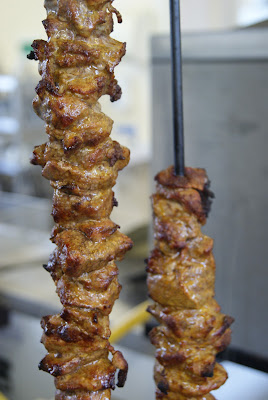Ingredients:
FOR MEATBALLS (Koftas):
500g minced chicken
Breadcrumbs
2 Tbsp tomato puree
½ tsp garam masala
½ tsp cumin
½ tsp madras curry powder
½ tsp black pepper
Bunch of fresh coriander- finely chopped
Salt to taste
Base curry sauce:
2 medium sized onions- peeled and sliced
3 medium sized carrots- cut into chunks
½ tsp tumeric
1 tsp chilli powder
Salt + pepper- to taste
5-6 eggs- hard boiled
1 medium sized onion
3 cloves of garlic- finely chopped
1” piece of fresh root ginger- peeled and finely chopped
2- 3 fresh beef tomatoes –peeled and chopped or 200 ml canned tomatoes
2 Tbsp tomato puree
½ tsp garam masala
½ tsp curry powder
½ tsp cumin
½ tsp chilli powder
½ tsp turmeric powder
¼ tsp cardamom powder
Oil + butter for frying
- Put all the ingredients for the Koftas in a large bowl and mix well together using your hands. Cover with cling film and put to marinade in the fridge for about 30 minutes.
- Meanwhile prepare base sauce for the curry. Slice your onions and cut carrots into chunks, add spices and enough water to cover the ingredients. Simmer on medium heat until the carrots soften. Take the pan off the heat and put aside to cool down. Then using hand blender blend the mixture to a soup-like base sauce. Put aside.
- Take out the kofta mixture from the fridge and stir it together once more.Always remember to dip you hands in water before making kofta balls, otherwise it will stick to the hands and will become shapeless. Start making small Kofta balls by taking the mixture little by little (smaller than a golf ball).
- Meanwhile heat up the oil and butter on the heavy-based pan and fry onions until light golden. Once the Onions get dehydrated and start to change colour. Add garlic and ginger and fry for another 2 minutes, until aromatic.
- Add all dry spices and stir together, until onions absorb colour and flavour.
- Now it’s time for kofta balls to go in. Gently drop the meatballs into the pan and fry on a low heat until lightly browned.
- Add tomato puree and tomatoes. Stir gently, so as not to break the meatballs. Fry for a few minutes, until tomatoes soften and sauce starts to thicken

- Pour prepared earlier base sauce over the meatballs and add boiled eggs.
- Increase the flame to medium and simmer for about 40 minutes until the koftas are fully cooked. If you want to make sure Koftas are cooked or not then , prick on the Koftas and if a watery juice comes out, its cooked. The gravy can be as thick as you like so add or dry up the water as required. However, at this point, your curry should have smooth and creamy consistency.
- Few minutes before taking the dish off the heat garnish with fresh coriander. Serve warm with rice or Indian flat breads and Kachumbar salad. Enjoy!!! J
Tips:
· Use any ground meat of your choice – turkey, beef or lamb. Some people also make vegetarian koftas.
· Make smaller Koftas for faster cooking.
· Instead of browning the koftas with onions, you can create the gravy first and drop the balls into boiling curry together with eggs. But please note the simmering time then may be slightly longer.
· Increase the amount of Garam Masala and Red Chili Powder to make it a spicier dish. Also can use a chopped fresh chilli- add it to your curry at the same time as garlic and ginger.








































